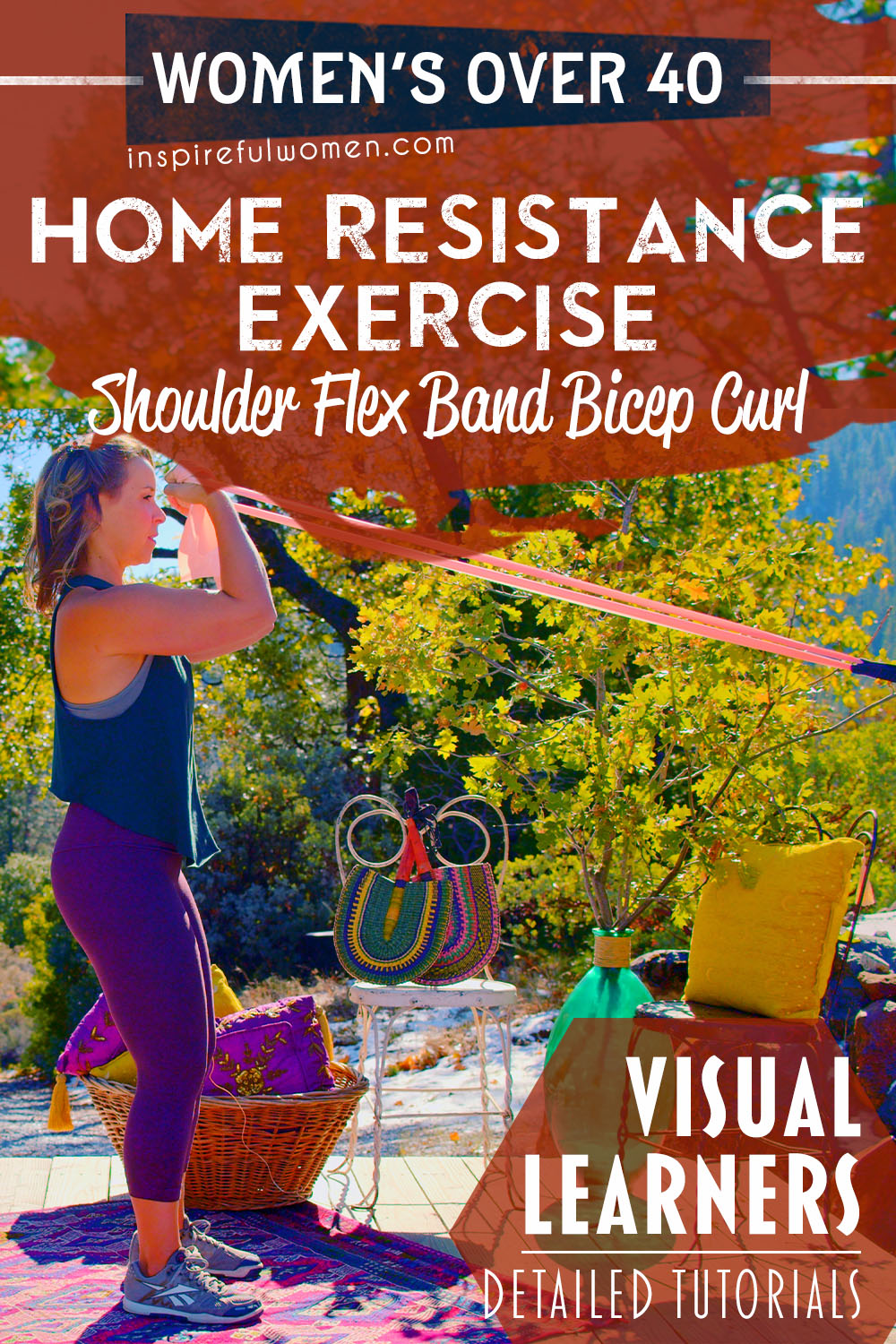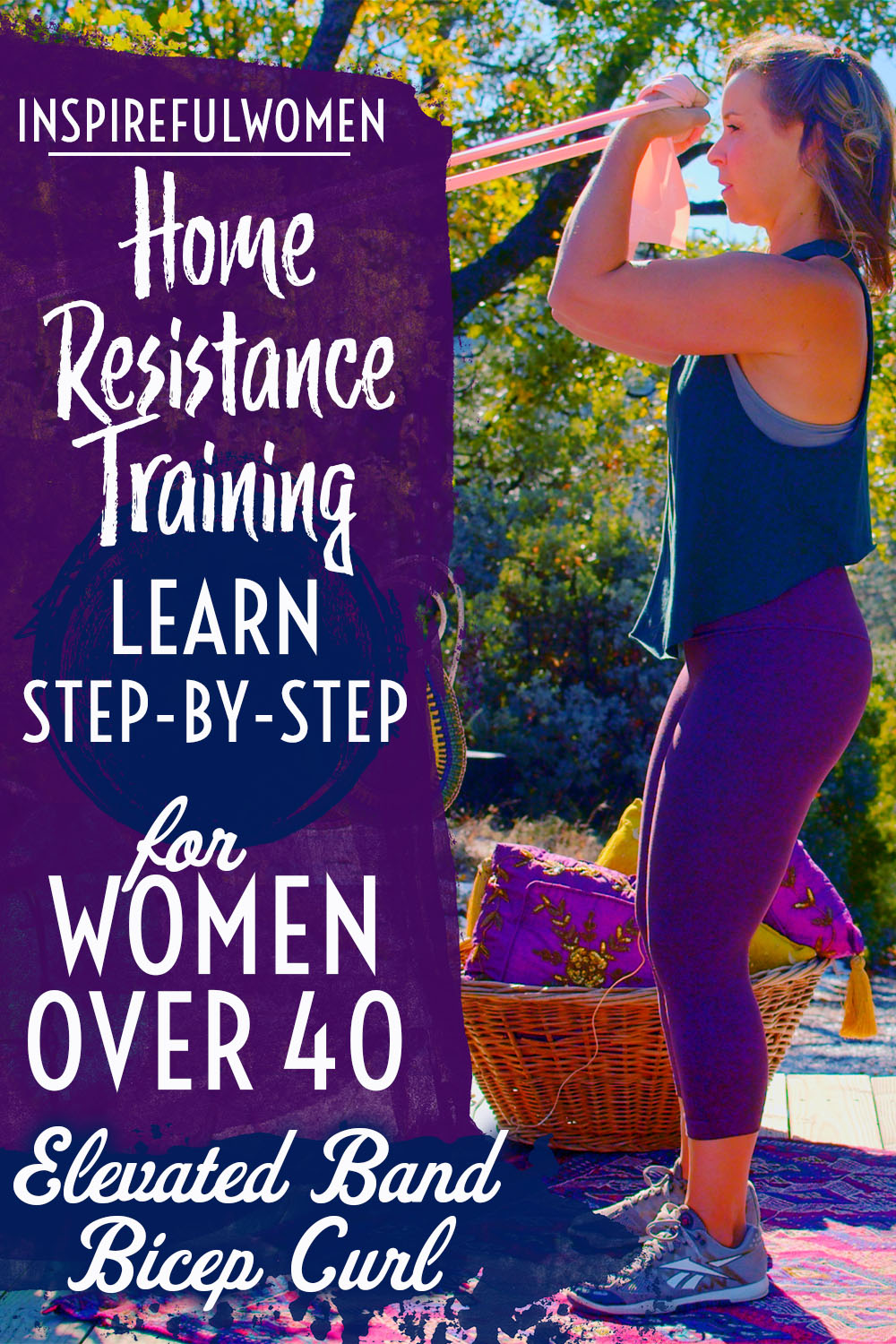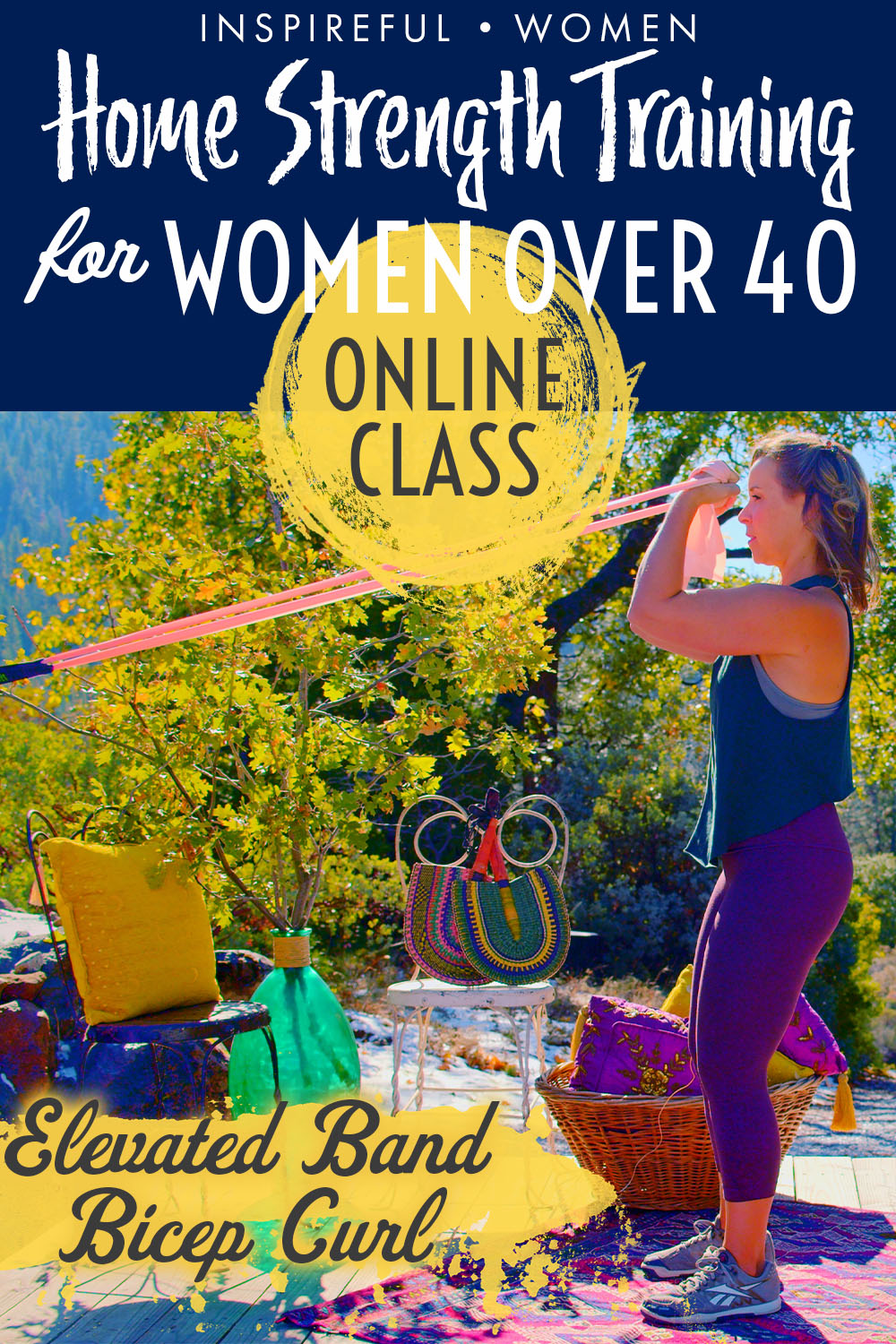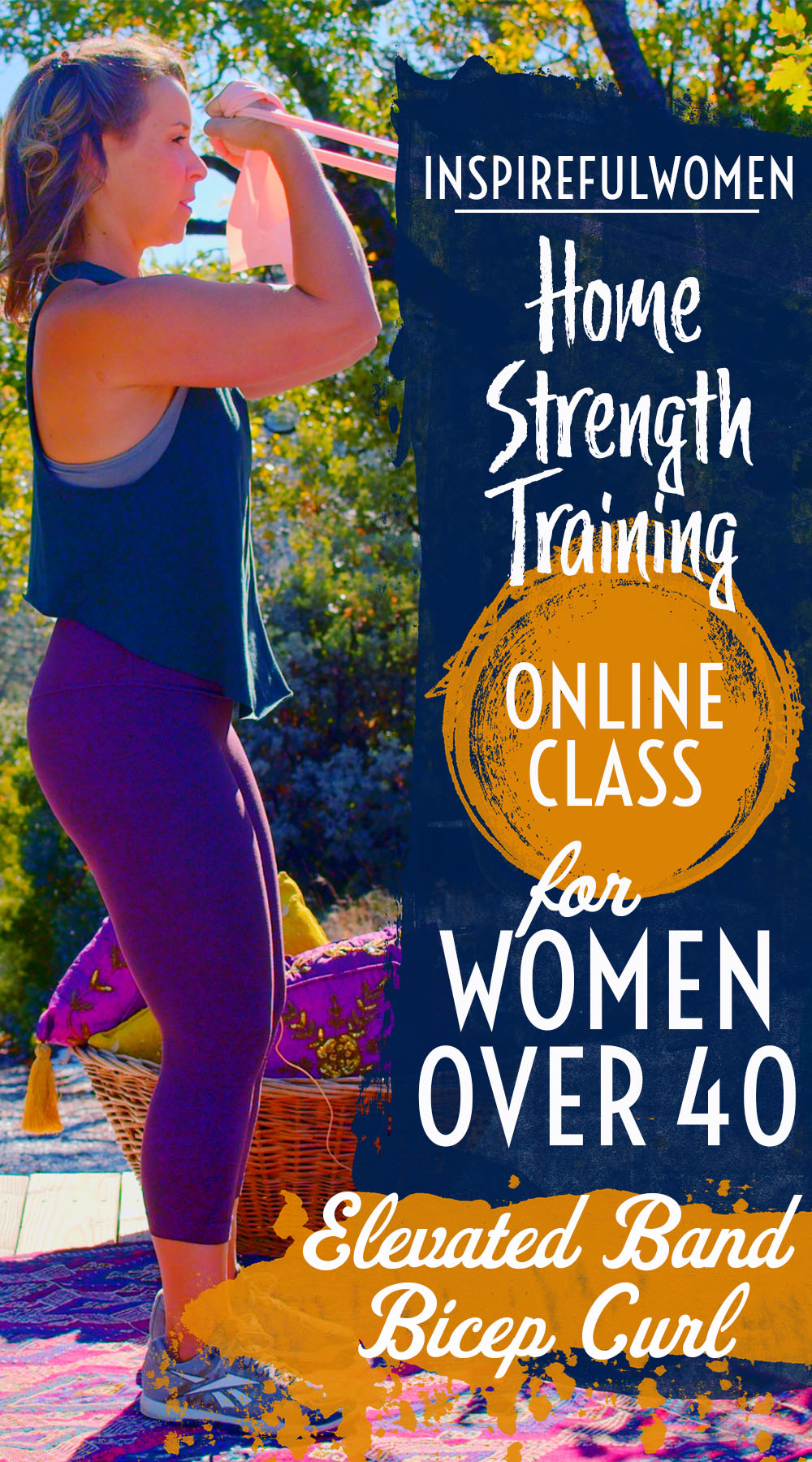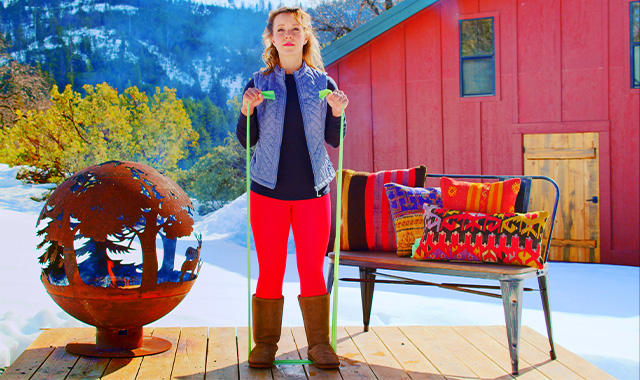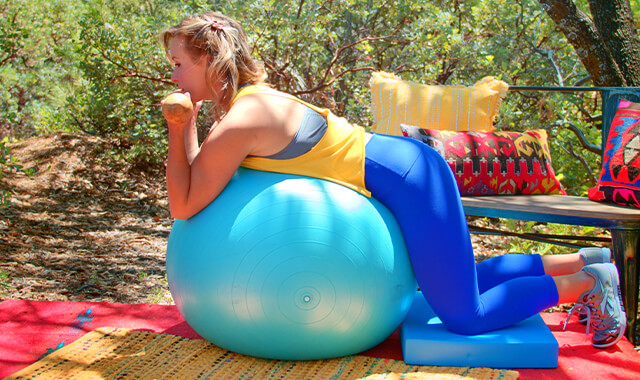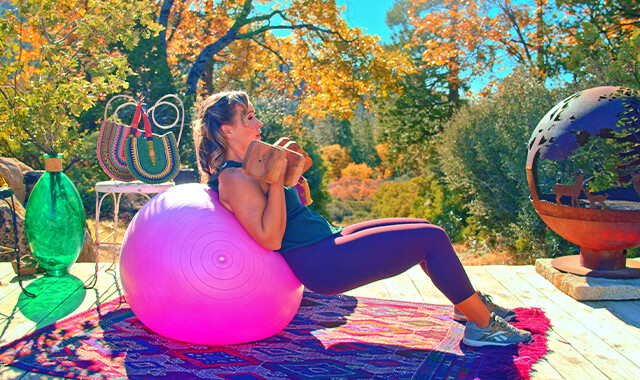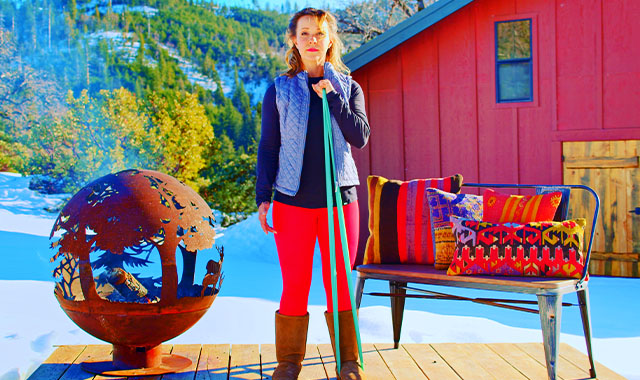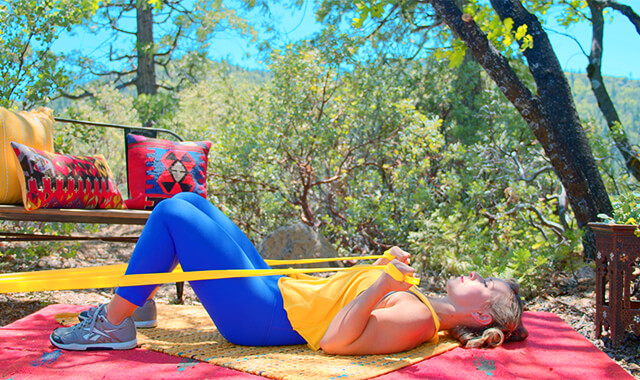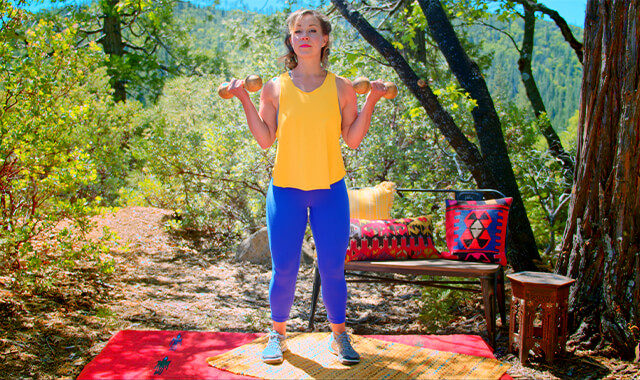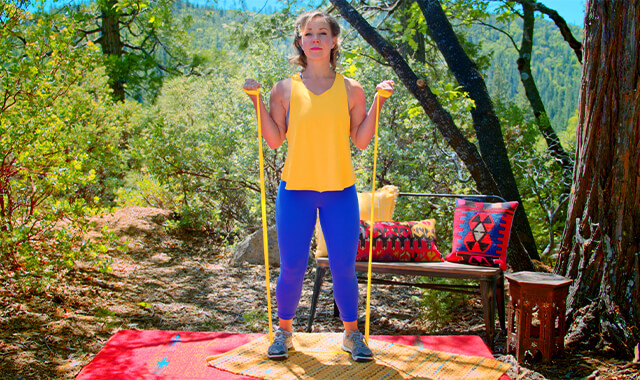Elevated Band Bicep Curls
How to Do the High Band Biceps Curl with Shoulder Flexion | In-Depth Guide [VISUAL LEARNERS] Intermediate
Proper Form, Common Mistakes, & Variations | Home Resistance Training
WHAT DO YOU WANT TO SEE?
QUICK DEMO
QUICK DEMO
MUSCLES THIS WORKS
MUSCLES
MAIN MUSCLES WORKED IN Elevated Band Bicep Curls
BICEPS BRACHII
OTHER MUSCLES WORKED:
- Forearms (supinator)
- Brachialis
STARTING POINTERS
Starting Pointers
WHAT WE'RE DOING TODAY
Other names for this exercise: Band Elbow Curls with Arm Lift, High Biceps Curl
This variation of the bicep curl exercise targets all of the biceps and also the upper back and anterior deltoid muscles. There is an added bonus of working the muscles on the backside of your body - from feet to neck, to hold the position against the pull of the band.
The movement is a combination of elbow bending (flexion), rotating the forearm (supination), and upper arm lift (shoulder flexion). The movement combination targets three of the main functions of the biceps muscle. A resistance band is used - so the resistance will increase as the band is stretched more, This will put the greatest load on the biceps at the end of the movement - when the elbow is most bent, the upper arm is lifted and the forearm is in supination. The biceps is stronger around the mid-range - the range where the forearm is closer to parallel with the floor. When the elbow bends further, the other elbow flexors (the brachialis and brachioradialis) will most likely start working harder to help out.
HOW TO DO THE EXERCISE
LOOKS
HOW Elevated Band Bicep Curls SHAPE OUR BODY
Bicep curls will tone and give you muscle definition in the front of your upper arm (where your bicep is haha!)
It helps give a curvy yet FIRM sculpted look to the arm.
PROPER FORM
PROPER FORM: Elevated Band Bicep Curls
EQUIPMENT, SETS & REPS
EQUIPMENT
Main set (3: Light/Med/Heavy)
X-Heavy Band (I recommend getting this too if you plan to use resistance bands frequently).
SUGGESTED STARTING WEIGHT FOR WOMEN:
Moderate resistance bands
SETS & REPS:
2 sets of 8 reps
PACE:
Quick up and slower down.
BODY POSITION
BODY POSITION FOR THE Elevated Band Bicep Curl
BAND: Anchor the band in front of you between your waist and low chest level. Hold one end of the band in each hand.
FEET: Standing with feet hip-width apart, knees slightly bent.
BODY STANCE: Neutral spine, shoulder blades in and down the back, sternum lifted.
ARMS: Lifting to your front, slightly lower than shoulder level, elbows straight. Step back until there is no slack in the band.
HAND/GRIP: Neutral grip (palms in, thumbs up) holding one end of the band in each hand. The band enters your hand on the side of your little finger, crossing your palm to your thumb side.
HOW TO DO
HOW TO DO Elevated Band Bicep Curls
CUE: Keep your arms right in front of your shoulders - not allowing them to lift out to the sides (this will start to use the lateral and posterior deltoid muscles).
Keeping your upper arms still, bend your elbows (flexion).
As your elbows bend, rotate your forearm so that the palm of your hands faces up to the ceiling (supination).
Continue to pull your hands up as far as you are able with good form and no discomfort.
Lift your arms up slightly so that your upper arm is parallel to the floor.
Slowly lower your upper arm back down to the starting level, straighten your elbows, and rotate your forearm so that your palms face in again.
Begin the next rep.
HOW TO SAFELY GET OUT OF THE EXERCISE
From the starting position, release the band.
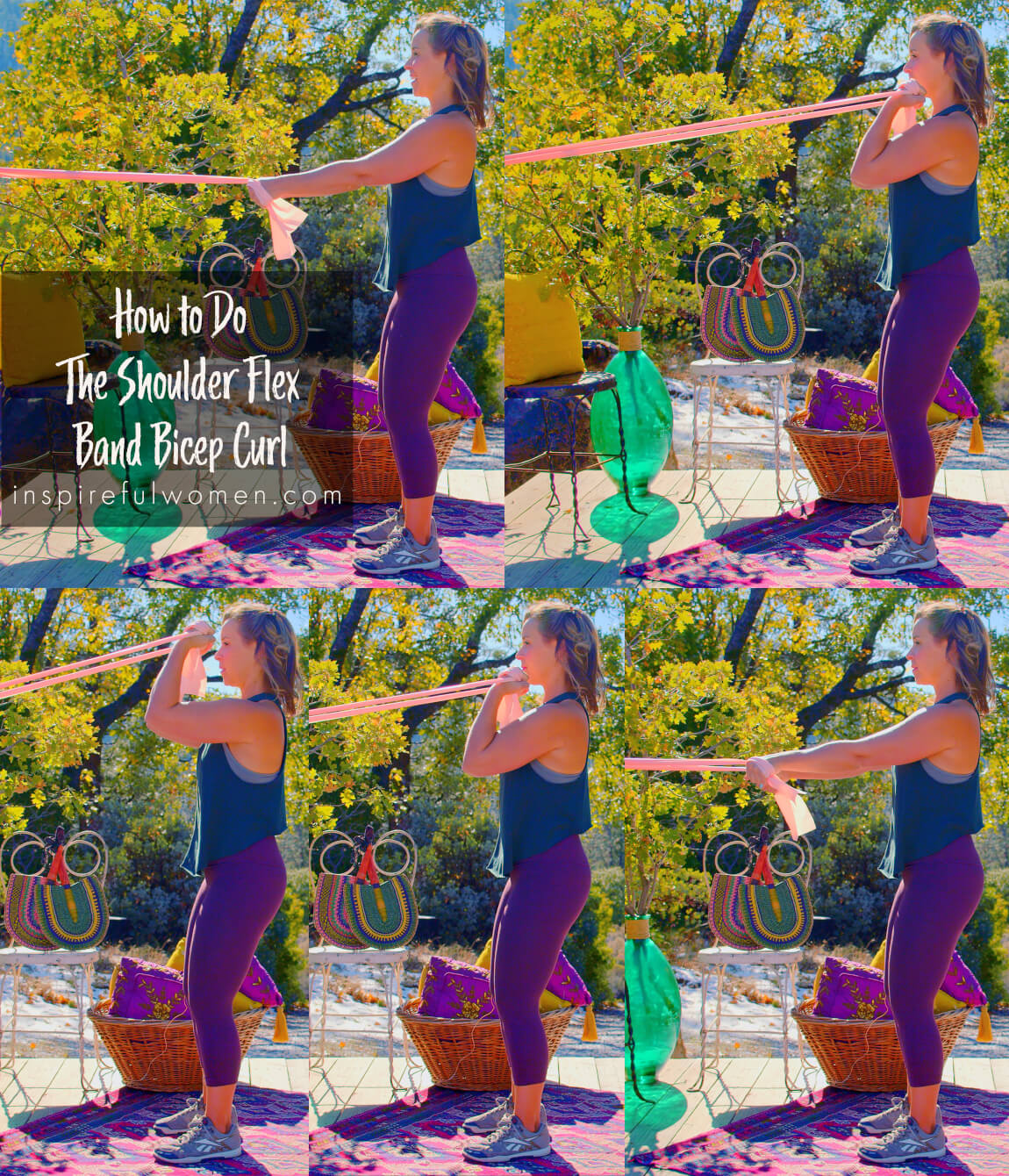
COMMON MISTAKES
COMMON MISTAKES
WHAT TO AVOID WITH THE Elevated Band Bicep Curl
KEY TIP:
Guess what? Good news! Many avoids are the same for most movements. Once you learn the basics, there's really only a few extra avoids for each individual movement.
1. Avoid Mounting Band too high
AVOID: Avoid mounting the band too high.
WHY NOT?
- This will involve using your upper traps instead of your biceps.
WHAT TO DO:
- Anchor the band in front of you between your waist and low chest level.

2. Avoid Leaning Back
AVOID: Avoid leaning back or shifting your weight.
WHY NOT?
- This will decrease the work being done by the muscles of the arms and upper back
- This is a common way the brain will try to make the exercise easier - using your body weight to help pull the hands up.
WHAT TO DO:
- Keep the shoulders over the hips, and over the feet, and keep your weight evenly distributed in your feet.
- Bend the knees slightly and activate your core muscles.

3. Avoid rounding shoulders
AVOID: Avoid rounding the shoulders forward.
WHY NOT?
- This means that you are trying to use the anterior deltoid and chest muscles to help bend the elbow.
- This can decrease the space between the shoulder blade and the upper arm bone (humerus) and irritate the tissues.
WHAT TO DO:
- Pull the shoulders blades in and down the back, lift the sternum to correct your posture.
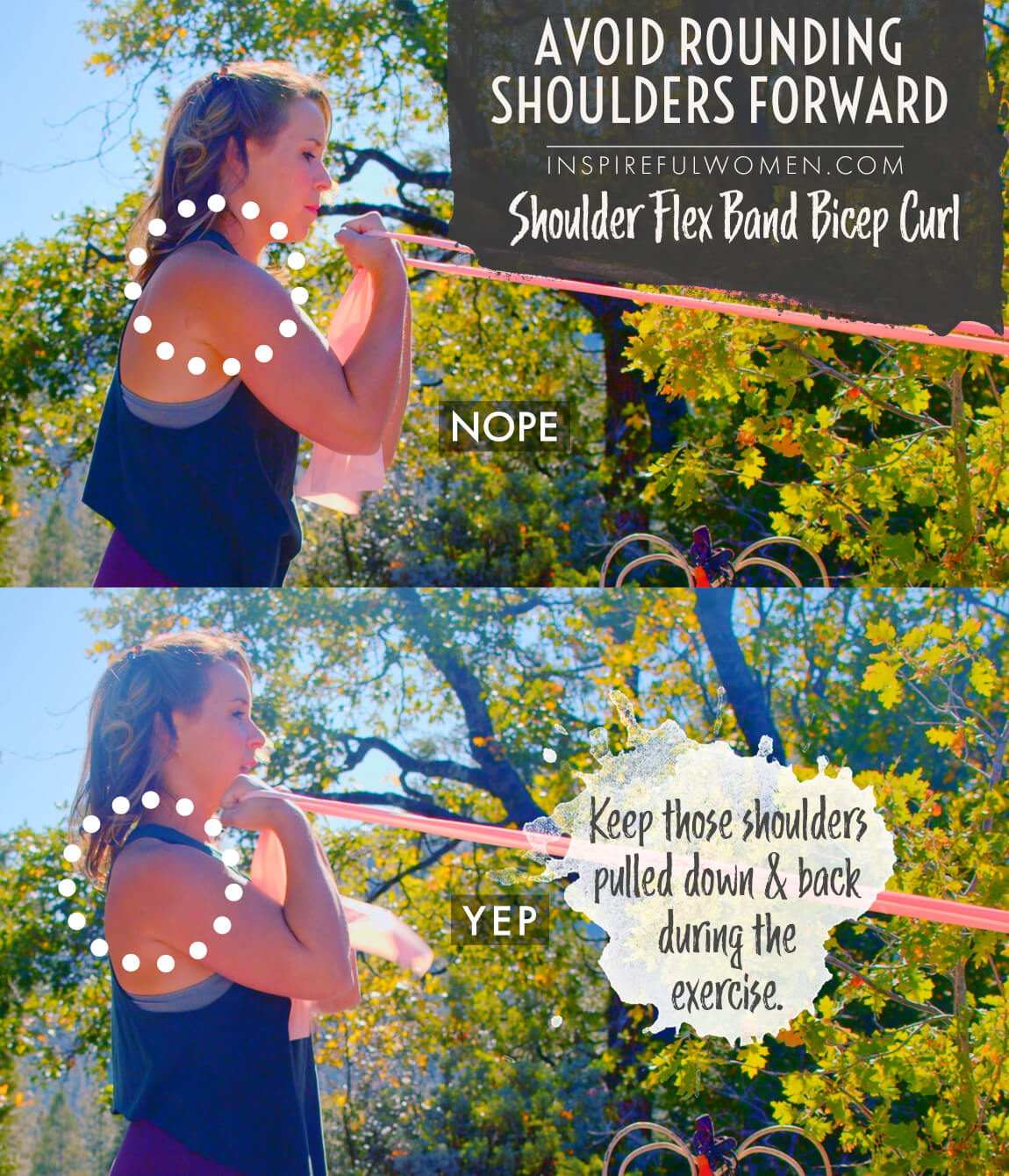
VARIATIONS
VARIATIONS
VARIATIONS OF Elevated Band Bicep Curls
extra eccentric
At the end of the movement - the forearm is supinated, elbow flexed, and upper arm lifted to shoulder level, While holding the position take a small step backward, hold for 1-2 seconds, and step forward again. This will increase the resistance from the band and keep some tension on the biceps for a longer period of time.
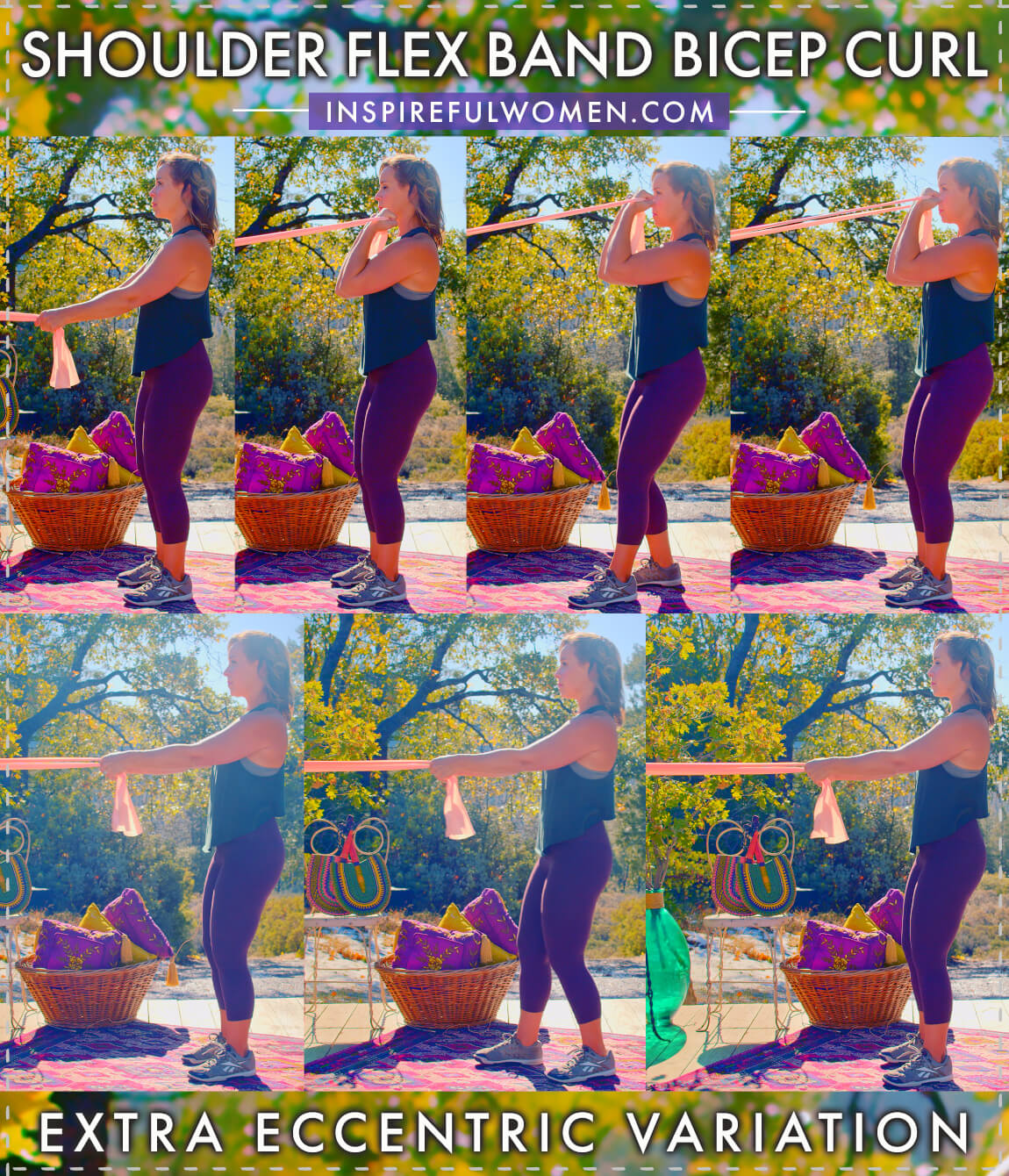
WHAT WE'RE DOING TODAY
WHAT & WHY
BENEFITS OF TRAINING THE Biceps
WHAT
The biceps brachii (bicep means that the muscle has two heads connecting at different places, and brachii - meaning arm) is the big muscle lying on the upper part of the front of the arm - between the elbow and the shoulder. This is probably the most well-known muscle of the arm - sometimes referred to as the beach muscle. The main function of the biceps brachii (not to be confused with the biceps femoris which is one of the hamstring muscles) is to bend (flex) the elbow, moving the hand closer to the body.
The biceps brachii also can rotate the forearm so that the palm is facing up. The rotation of the forearm is due to one of two long bones in the forearm rotating across the other. This is called supination.
Most of the exercises for the biceps muscle most effectively are movements that combine bending (flexing) the elbow with rotating the forearm to a palm-up position (supination). The bicep is a big, powerful muscle. Exercises that target this muscle can usually be done with quite a bit of resistance.
WHY BOTHER DOING IT?
WHY
WHY DO WE EVEN CARE?
Crossfitting for 8 years we never did specific bicep work, and most of the movements didn’t really work your biceps much. Once I started doing bicep curls regularly, I noticed a big difference. One day I needed to carry a 5-gallon bucket of stuff in each hand for quite a long distance. I was amazed at how much easier it felt than a while back! That’s from the biceps being stronger. This is also helpful for holding other things in your arms - a stack of books, children, getting all the groceries into the house in one trip, pulling heavy pans full of turkey and potatoes out of the oven, carrying a load of firewood, or a stack of lumber.
The biceps brachii crosses the shoulder joint, so it is able to lift the arm up (shoulder flexion). Since it crosses both the elbow and the shoulder it plays a role in stabilizing those joints. The job of the arm is to move the hand to where it needs to be, and then to hold the arm still as the hand does what it needs to do. The biceps is extremely important for both moving the arm through an endless number of positions and holding it still. Strong biceps will make everyday life activities easier and will improve the health of your elbows and shoulders.
EVERYDAY LIFE
EVERYDAY LIFE &
MUSCLE FUNCTION
HOW WE USE OUR biceps MUSCLES IN EVERYDAY LIFE
1. BENDING THE ELBOW (ELBOW FLEXION)
- Eating
- Lifting glass for drinking
- Dressing
- Lifting
- Carrying
- Washing/brushing hair
- Stirring
- Painting
- Brushing your teeth
- Weeding
- The list is pretty much endless...
2. TURNING YOUR FOREARM UP (SUPINATION)
- Turning a doorknob
- Using a screwdriver
- Turning a key
- Turning a spigot
- Receiving change
- Carrying a plate
3. LIFTING THE ARM (SHOULDER FLEXION)
- Reaching up
- Dressing
- Pushing a window up
- Washing windows
- Lifting up to the front - kids, boxes
- Carrying in front: kids, groceries, books
4. STABILIZING THE ELBOW AND SHOULDER
- Writing
- Knitting
- Reading a book
- Using a screwdriver
- Holding items in front of you - carrying a heavy box, pushing a wheelbarrow
HOW TO FEEL WHAT MUSCLE IS WORKING
How to Feel What Muscle is Working
Bend your elbow. Place the other hand on the upper arm with the bent elbow. Lift a heavy object with the arm - you will feel the biceps contract under your hand.
SCIENCY STUFF
ALLLL MUSCLES & WHEN
ALL MUSCLES WORKING & WHEN DURING THE Elevated Band Biceps Curl
The biceps brachii and the brachialis, work concentrically to bend the elbow. The brachioradialis does not contribute unless power or speed is needed – for quicker movements or heavy loads.
The supinator will be active with the biceps brachii to supinate the forearm.. Wrist flexors (n palmaris longus, flexor carpi radialis, flexor carpi ulnaris) hold the wrist in neutral.
The biceps brachii and brachialis work eccentrically to straighten the elbow and return to the starting position.
PIN IT FOR LATER!
